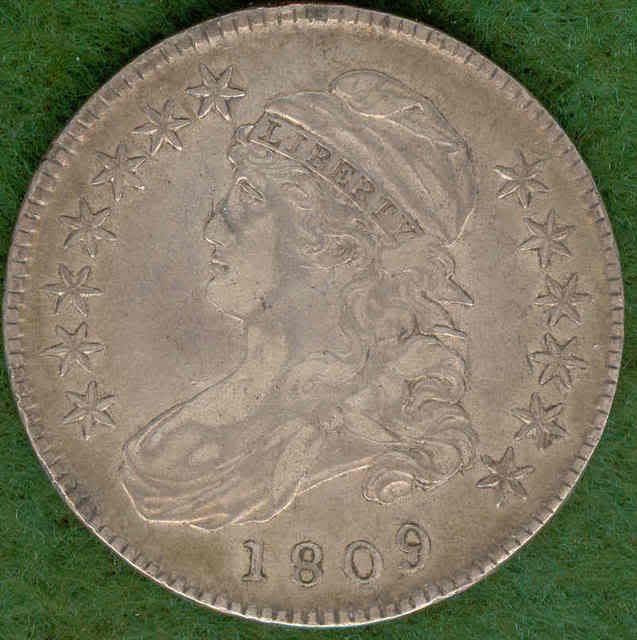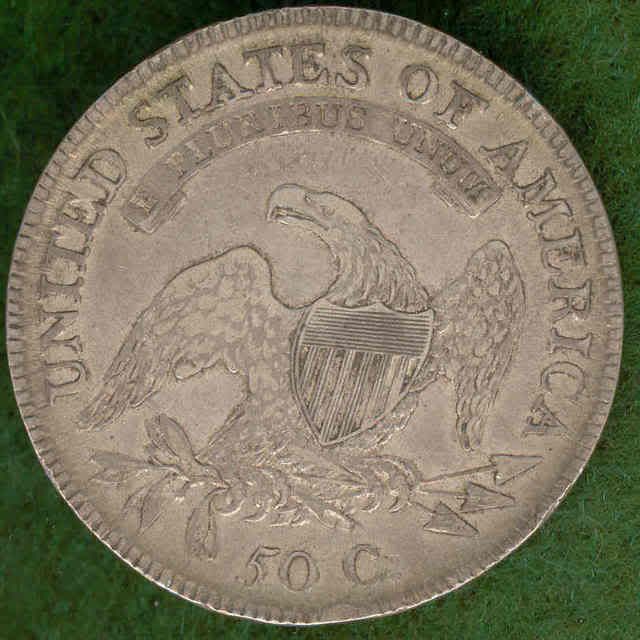For Sale: 1809 Bust Half Dollar---SOLD 11/1/07
I have for sale an 1809 Bust Half Dollar. SOLD SOLD SOLD SOLD SOLD SOLD, THANK GOODNESS, I SOLD IT!
This coin was struck using Obverse Die 2-s2 and Reverse Die A-s2. The obverse has the first die crack and part of the additional die crack as described in the Overton/Parsley book for the 1809 O-102a. The reverse has no die crack.
By the Overton Numbers, this is an Intermediate Die State O-102a Obv/O-102 Rev. The coin has the plain edge.
This raw coin was cracked out of a PCGS EF-45 holder.
This is an original looking med/dark gray coin with hints of luster around all of the edge devices. The left wing and eagle's head were weakly struck - as typical for this die marriage.
Also, this eye appealing coin shows the normal signs of wear and very minor edge dings from limited circulation. No scratches or hairlines are noted.
I am asking $375 for it delivered. U.S. sales only, please.
If you like the coin but are uncomfortable with my price, PM me and I will listen
...and please PM me for payment terms.
Thank you for looking at my coin.
Ed R.


This coin was struck using Obverse Die 2-s2 and Reverse Die A-s2. The obverse has the first die crack and part of the additional die crack as described in the Overton/Parsley book for the 1809 O-102a. The reverse has no die crack.
By the Overton Numbers, this is an Intermediate Die State O-102a Obv/O-102 Rev. The coin has the plain edge.
This raw coin was cracked out of a PCGS EF-45 holder.
This is an original looking med/dark gray coin with hints of luster around all of the edge devices. The left wing and eagle's head were weakly struck - as typical for this die marriage.
Also, this eye appealing coin shows the normal signs of wear and very minor edge dings from limited circulation. No scratches or hairlines are noted.
I am asking $375 for it delivered. U.S. sales only, please.
If you like the coin but are uncomfortable with my price, PM me and I will listen
...and please PM me for payment terms.
Thank you for looking at my coin.
Ed R.


0
Comments
Capped Bust Half Series
Capped Bust Half Dime Series
Jeff
Sometimes you cannot always see the die cracks on a Bustie when it in the holder. Certainly you cannot see and study the edge lettering.
I just like to be able to pick up and study my coins. Raw coins are easier for me to safely store.
In the case of this 1809, this is a clear example of what can happen when you have a slabbed coin. I bought the coin slabbed as an O-102 XXXX Experimental Edge.
When I broke the coin out to put it in my album, I noticed PVC contamination around the date. This was old contamination, it was now black instead of the customary green.
I gave the coin an acetone bath to remove the contamination. Now I could see die cracks where the contamination (black spots) had been - this told me that it was not the O-102 obverse struck with the earlier die state of Obverse Die 2. Looking at the edge, I discovered that the coin was not the XXXX Edge. It was the Plain Edge, which sells for less money.
I have actually put his coin on the BST Forum for less than I paid for it. After all, it does not have the XXXX Edge.
*****
As a collector I broke out my coins, because this was how I liked to have them - for my own personal reasons and satisfaction.
Now that I am getting older and have to start looking at my coins not only as a hobby, but as an investment, I wish they were all still in their plastic coffins.
This is my excuse. ...and I am sticking with it.
Thank you for asking,
Ed R.
PS: In this case, the 1809 looks a lot better in hand (condition and grade-wise) than it does in my scans.